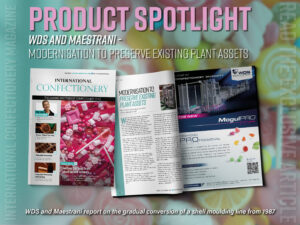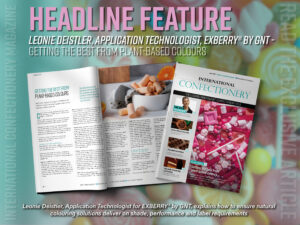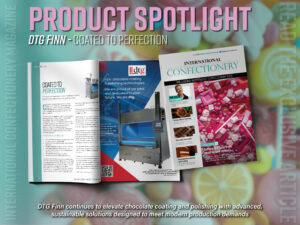Leonie Deistler, Application Technologist for EXBERRY® by GNT, explains how to ensure natural colouring solutions deliver on shade, performance and label requirements
Colours made from fruits, vegetables and plants can be used to achieve a complete spectrum of vibrant, stable shades in confectionery.
They are ideally suited to the demands of the modern market, with consumers increasingly seeking out natural ingredients amid the ongoing backlash against ultra-processed food.
However, plant-based colours require careful formulation to ensure best results. It is important to select the most suitable raw materials and formats for the individual application. In addition, manufacturers may need to consider how different plant-based colours will appear on the ingredient list.
This article provides an overview of some of the key considerations when using plant-based colours in confectionery applications.
A rainbow of plant-based shades
The EXBERRY® colour portfolio contains a complete spectrum of shades made from more than 30 different types of non-GMO fruit, vegetables and plants.
Each raw material has its own technical considerations, including potential sensitivity to pH levels, heat and light. The most suitable option will depend on individual application requirements.
Red: Red EXBERRY® colours are created from raw materials including radish, red sweet potato, black carrot and blackcurrants. In the UK and EU, a labelling example could be “carrot and blackcurrant concentrates”. These red concentrates contain anthocyanin pigments, which are not sensitive to heat or light but can shift to a less stable, bluish shade at higher pH levels. For high-pH products, a blend of concentrates such as reds and yellows can be the best strategy.
Pink: Purple sweet potato and carrot can provide an excellent source of pink hues in low-pH applications and can be labelled simply as “sweet potato and carrot concentrates”. Beetroot, meanwhile, is pH-independent but is less heat stable and light stable than colours based on anthocyanin pigments. The stability of beetroot-based colours can be improved with the addition of antioxidants such as ascorbic acid. They may be labelled as “beetroot and carrot concentrates”. As with reds, some projects may benefit from a blend of colours.
Yellow: Carrots, pumpkins, turmeric, safflower and algal carotene are among the options for yellows. Most yellow colours contain carotenoid pigments, which are heat stable. Their light stability depends on the application but can be improved with the addition of ascorbic acid if required. Turmeric creates vibrant shades that increase in intensity when exposed to high temperatures. It is sensitive to light and so the choice of packaging is important. Safflower, meanwhile, can deliver bright shades while offering good heat and light stability. All are pH-independent and label examples include “pumpkin and apple concentrates”, “safflower and lemon concentrates” and “colour: algal carotenes”.
Orange: Concentrates made from raw materials including carrot, peppers and paprika can provide pH-independent sources of orange. As with yellow carotenoid-based colours, ascorbic acid may be required to enhance light stability in some cases. Label examples include “pepper and carrot concentrates” and “paprika oil”. Orange shades can also be achieved by blending red and yellow raw materials. The red colours contain anthocyanin pigments, which require lower pH levels for optimal performance. These colours are heat and light stable and can be labelled as “radish and safflower concentrates” or “sweet potato and safflower concentrates”.
Blue: The superfood spirulina is used to provide a spectrum of naturally vibrant, light-stable blues in food and drink applications. It can be labelled as “spirulina concentrate” and contains the pigment phycocyanin. To ensure best results, it is important to minimise exposure to heat and acid as much as possible or to slightly increase the dosage.
Green: It is possible to achieve vibrant green shades in a wide range of applications by blending blue spirulina concentrates with yellows. Spirulina and safflower concentrates are often light stable but this depends on the application. Spirulina and turmeric concentrates are light sensitive and are best suited to products in opaque packaging.
Purple: Raw materials including carrots, blueberries and hibiscus offer good heat and light stability, although they can be affected by pH levels. Label examples include “carrot and blueberry concentrates” and “carrot and hibiscus concentrates”. It is also possible to achieve purple and lavender hues by mixing spirulina with reds and pinks.
Brown: Brown shades can be achieved using a variety of raw materials including caramelised sugar syrup, caramelised carrot and apple. There is also a brown EXBERRY® product for hard-panned confectionery made from purple carrot, safflower and spirulina. Lighter browns made from caramelised sugar syrup, apple or caramelised carrot are light stable, heat stable and pH-independent. Darker browns made with caramelised sugar syrup and caramelised carrot contain additional black carrot and are therefore pH-dependent. The purple carrot, safflower and spirulina concentrate is sensitive to both heat and acid. Label examples include “caramelised sugar syrup and carrot concentrates”, “apple concentrate” and “carrot, pumpkin and spirulina concentrates”.
Read the full cover story in our latest issue here









